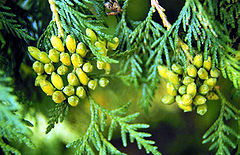This is an old revision of this page, as edited by ජපස (talk | contribs) at 20:35, 24 January 2008 (On closer review, it is discovered that both sources are unreliable sources for plants. One is from a fringe journal, the other is from a fringe publishing press.). The present address (URL) is a permanent link to this revision, which may differ significantly from the current revision.
Revision as of 20:35, 24 January 2008 by ජපස (talk | contribs) (On closer review, it is discovered that both sources are unreliable sources for plants. One is from a fringe journal, the other is from a fringe publishing press.)(diff) ← Previous revision | Latest revision (diff) | Newer revision → (diff)
| Thuja occidentalis | |
|---|---|

| |
| Thuja occidentalis foliage and cones | |
| Conservation status | |
 Least Concern | |
| Scientific classification | |
| Kingdom: | Plantae |
| Division: | Pinophyta |
| Class: | Pinopsida |
| Order: | Pinales |
| Family: | Cupressaceae |
| Genus: | Thuja |
| Species: | T. occidentalis |
| Binomial name | |
| Thuja occidentalis L. | |
Thuja occidentalis, a species of thuja, is an evergreen coniferous tree in the cypress family Cupressaceae, native to the northeastern U.S. and southeastern Canada, from central Saskatchewan east to New Brunswick, and south to eastern Tennessee in the Appalachian Mountains. Common names include Eastern Arborvitae, American Arborvitae, Techny Arborvitae, or just Arborvitae, the last particularly in the horticultural trade. Other names by which it is known include Northern Whitecedar, Eastern Whitecedar or White Cedar (although it is not a true cedar), and "Swamp Cedar". Thuja occidentalis should not be confused with the Chinaberry, Melia azedarach, an Australian deciduous tree sometimes also known as White Cedar.
Unlike the closely related Thuja plicata (Western Redcedar), it is only a small tree, to 10-20 m tall and 0.4 m trunk diameter (exceptionally to 30 m tall and 1.6 m diameter). The bark is red-brown, furrowed and peels in narrow, longitudinal strips. The foliage forms in flat sprays with scale-like leaves 3-5 mm long. The cones are slender, yellow-green ripening brown, 10-15 mm long and 4-5 mm broad, with 6-8 overlapping scales.
Ecology
Thuja occidentalis grows naturally in wet forests, being particularly abundant in swamps where other larger and faster-growing trees cannot compete successfully. It also occurs on other sites with reduced tree competition such as cliffs. Although not currently listed as endangered, wild Thuja occidentalis populations are threatened in many areas by the very high deer numbers encouraged by hunting associations; deer find the soft evergreen foliage a very attractive winter food, and strip it rapidly. The largest known is 34 m tall and 175 cm diameter, in South Manitou Island within Leelanau County, Michigan. It can be a very long-lived tree in certain conditions, with notably old specimens growing on cliffs where they are inaccessible to deer and wildfire; the oldest known living specimen is just over 1,000 years old, but a dead specimen with over 1,500 growth rings has been found. These very old trees are, despite their age, small and stunted due to the difficult growing conditions.
Uses
Thuja occidentalis is very widely used as an ornamental tree, particularly for screens and hedges. Over 300 cultivars have been selected and named for garden use; some of the commoner in the horticultural trade include 'Degroot's Spire', 'Ellwangeriana', 'Hetz Wintergreen', 'Lutea', 'Rheingold', 'Smaragd' (a.k.a. 'Emerald Green'), 'Techny', and 'Wareana'. It was introduced into Europe as early as 1540 and today is widely cultivated there, especially in parks and cemeteries.
The foliage of thuja is rich in Vitamin C and is believed to be the annedda which cured the scurvy of Jacques Cartier and his party in the winter of 1535–1536. Due to the neurotoxic compound thujone, internal use can be harmful and is not recommended.
White cedar is the preferred wood for the structural elements, such as ribs and planking, of birchbark canoes and the planking of wooden canoes.
References
- Russell M. Burns and Barbara H. Honkala (Technical Coordinators) (December 1990). "Thuja occidentalis L.: Northern White-Cedar". Silvics of North America (Agriculture Handbook 654).

